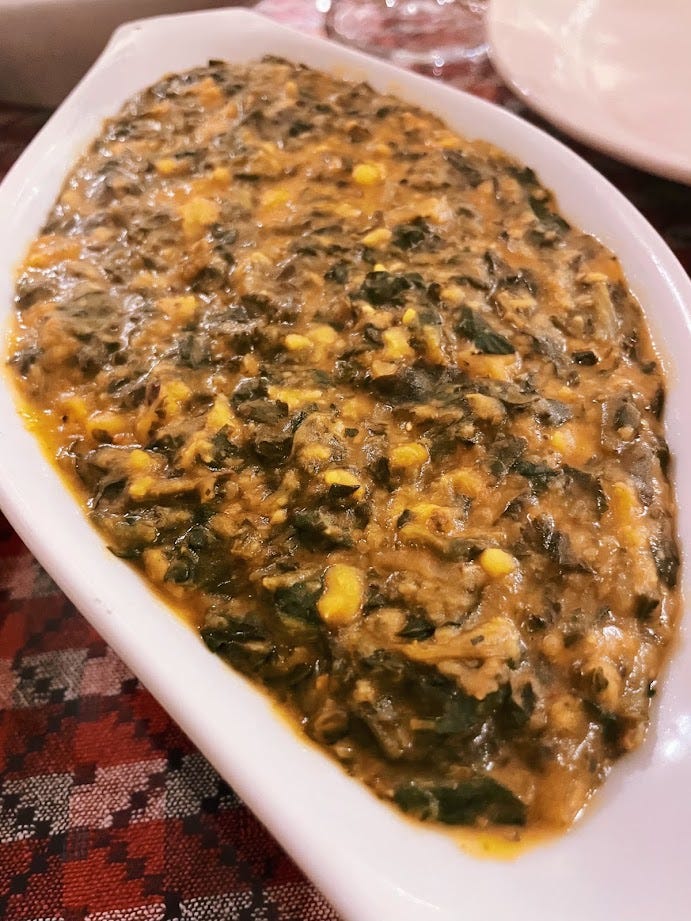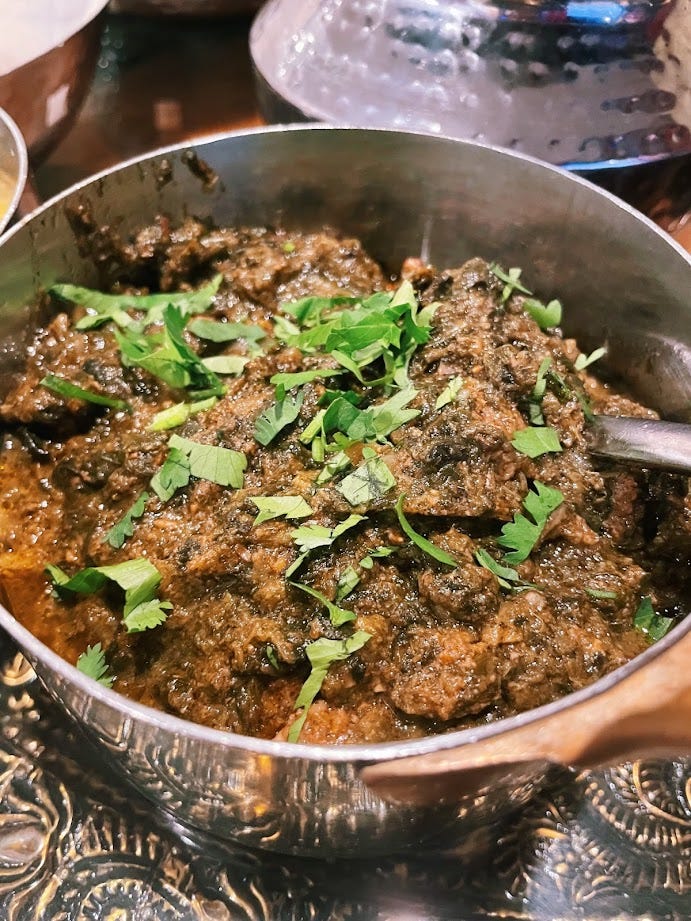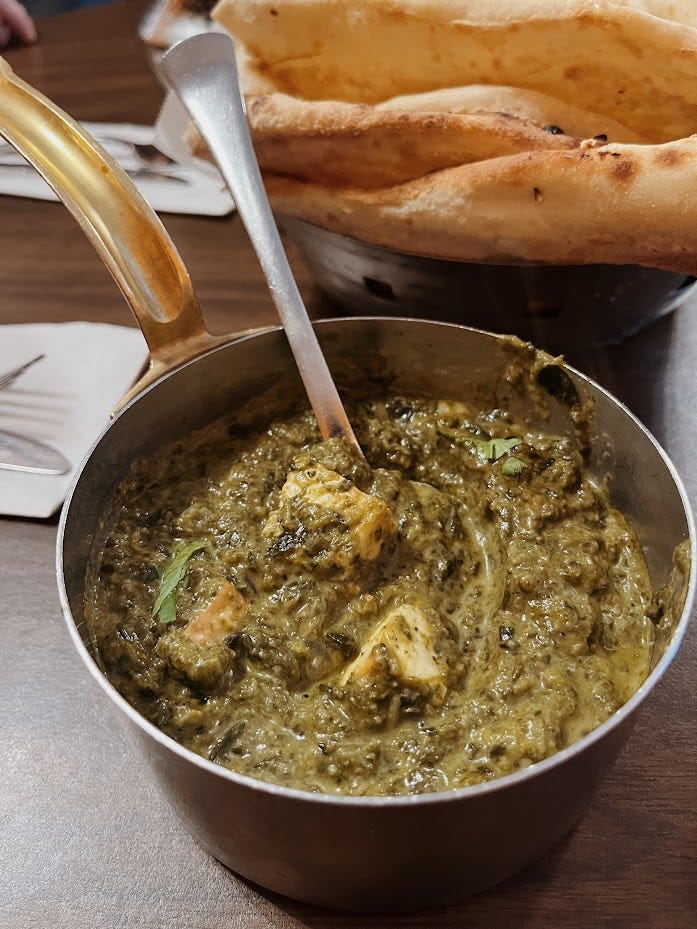Harrisonburg’s Best Saag
Nepal rests upon India’s shoulder, a slice of land embroidered with massive snow-capped mountains. Roughly 75 percent of Nepal is covered by mountains, including the highest range in the world, the Himalayas, with Mount Everest topping out at almost 30,000 feet. For perspective, the highest peaks in Virginia don’t surpass 6,000 feet.
Coincidentally, the owners of Indian-American Cafe, Taste of India, and Taj of India all traded Nepal's craggy peaks and steep slopes for the gentle roll of the Blue Ridge.
All restaurants serve Indian and Nepali-style dishes, with saag being a local favorite.
Saag is the Hindi word for spinach or other leafy green. The spinach, or other greens are seasoned with spices like ginger, coriander, and cumin, transforming into a silky gravy.
I indulged in four types of saag from all three restaurants: chicken saag, dal saag, paneer saag, and lamb saag. I wholeheartedly recommend the saag at all three restaurants and will continue to frequent them all, but throughout the tasting process my favorites emerged.

Court Square’s bell sounded seven times to mark the hour as I sat in Indian-American Cafe, looking out at the cars passing on Main Street. I lifted my heavy glass chalice of water and listened to the phone ringing off the hook for take-out orders, the majority of which were for chicken saag.
“I can’t tell you how many we make each day,” shared the waiter. New owner and chef Bijaya (BJ) Dulal confirmed chicken saag’s cult following. “[Our customers] don’t forget this place for the spinach curry.”
“We are still standing because of the spinach,” added BJ as he explained the challenges of operating a restaurant during a pandemic. The cornerstone recipe was developed by their relatives, Rama and John Shrestha who opened Indian-American in 1995.
BJ and his business partner Shiva Lamichhane took over for John and Rama on January 1, 2022.
BJ’s interest in food began at his grandmother’s table in Nepal and continued in culinary school and hotel kitchens in Nepal, India, and New York City. The transition of the restaurant was built on trust and good cooking.
“This is their baby. They spent more than 20 years. They don’t want to sell it. Nobody wants to give away the kids to the others.” But, working 10 hours a day, 6 days a week into their 80’s, John and Rama were tired.
“We can do whatever you guys used to do for 20 years with certain recipes. But I cannot give 100%. Their experience was half my lifetime. They have their own way,” explained BJ.
The transition was hard at first. Loyal customers expected the dishes to be identical to John and Rama’s.
But BJ and Shiva have proven they can serve generous portions of Indian-American classics and add their own touch to the menu. One of my new favorites is the momo, Nepalese dumplings steamed or fried and filled with mixed vegetables or chicken.
“We learn every single day until we go to the grave. We don’t stop improving. Whatever we have to work on, we work on,” promised BJ.

The turmeric yellow walls of Taste of India glowed with early afternoon light as I shared a steaming cup of chai with Ashok and Sita Kunver.
This culinary power couple has been in business together since 1997 when they opened the first Taste of India in Connecticut.
They laughed as they recalled the mistake that brought them to Harrisonburg. “We tried to go to GMU, but instead came here,” said Sita, gesturing to the window with a view of University Boulevard with JMU’s east campus a stone’s throw away.
They began serving Ashok’s North Indian recipes at Taste of India in 2008 and Taj of India in 2016.
Recipe development is an art Ashok learned from his father, who honed his skills as a curry chef at India’s first 5 star hotel. When Ashok’s father wasn’t cooking for the restaurant, he was cooking food for his family.
“He always loved the tandoori chicken,” said Ashok, remembering his father’s favorite dish. “We used to have a small clay oven at home, so we used to cook there.”
Sita grew up cooking as a hobby and necessity for her four siblings, parents, and farm employees in Nepal. She often cooked vegetarian dishes, incorporating the seasonal vegetables from the family farm.
At home, Sita would prepare saag with spinach, mustard greens, or methi leaves (fenugreek). In the restaurants, they use finely chopped spinach for their saag, a dish that even Sita can’t resist. “I love the chicken saag from my restaurant,” she said.
Friendly City residents weren’t always ready to dig into a steaming dish of rice and Taste’s most popular dishes, chicken tikka masala and butter chicken.
“When we came over here people really didn’t know about the Indian food and we have to be very patient, we have to make a very milder food,” explained Ashok. “Now we are starting to make a little bit spice because people now want it spicy. This is a multicultural town.”
“After a couple of years we started getting the good business. And until now,” Ashok paused to knock on the wooden table, “We are doing good.”
The Saag
The rice at all three restaurants earned full marks. At Indian-American, BJ prefers to let the fragrant nuttiness of the basmati rice shine on its own. At Taj and Taste of India, Ashok and Sita prepare rice flecked with whole spices: cumin, clove, and cardamom. If you’re lucky, you’ll get a whole cardamom pod in your bite of saag, filling your mouth with pungent herbal flavor.
Indian American’s chicken saag is famous for its tender, shredded dark meat and spinach bathing in a rich curry sauce. BJ theorized about the chicken saag’s popularity saying, “Not all the people like vegetables, not all people like protein, they have the right choice to get the vegetable and the protein at the same time.” Chicken and spinach are meant for each other in this dish.
If you’re looking for comfort food, look no further than Indian-American’s dal saag. The yellow lentils dissolve into the curry sauce, making a soft nutty blend that pairs perfectly with steaming hot rice. You could eat this dish with a spoon.
Taj of India’s lamb saag emerged as the best. The red meat lends a rich flavor to the saag. The tender chunks absorb the earthy turmeric and cinnamon flavors creating a savory curry sauce.
Taste of India’s paneer saag earns the crown. While Indian-American chooses to fry their paneer, Taste of India folds the fresh cheese directly into the saag without frying it. The texture is almost like tofu, soft and not rubbery or squeaky. The saag is almost fluffy in texture, light and delicious.
We in the Friendly City are lucky to get this taste of Nepal and North Indian cooking in Harrisonburg. You will not be disappointed after a trip to any of these restaurants. I, of course, recommend the saag.








